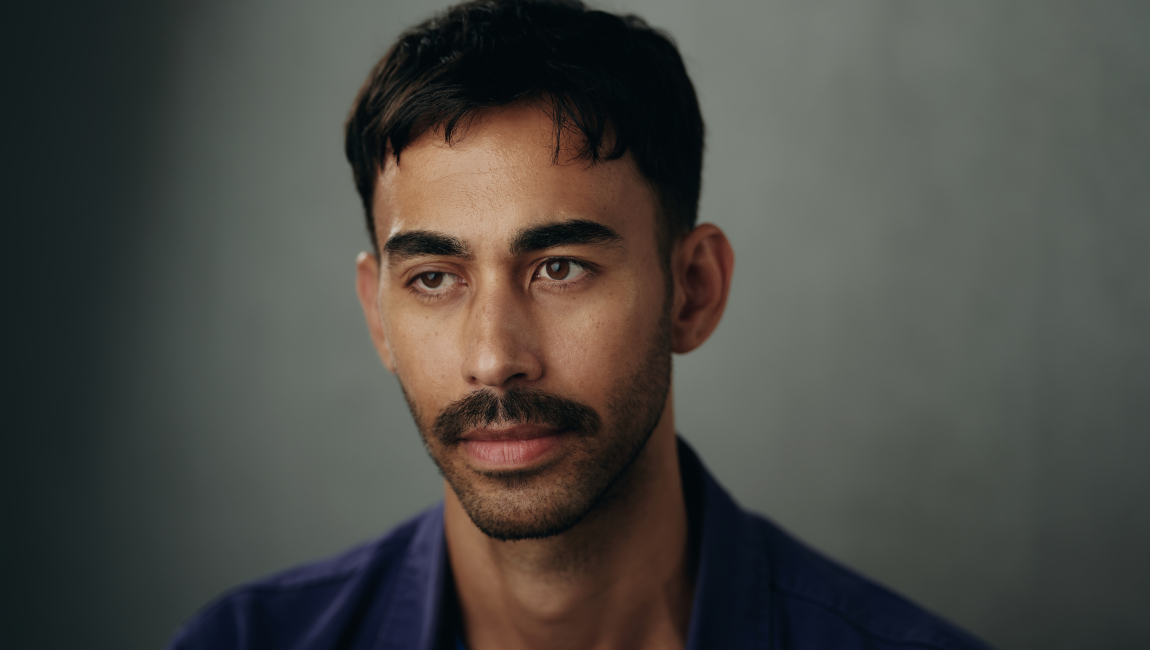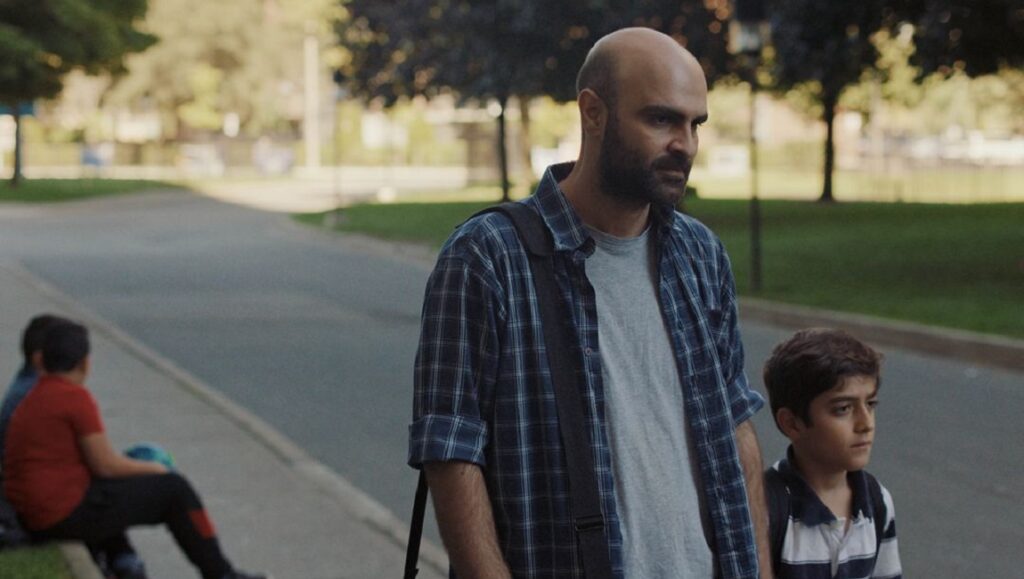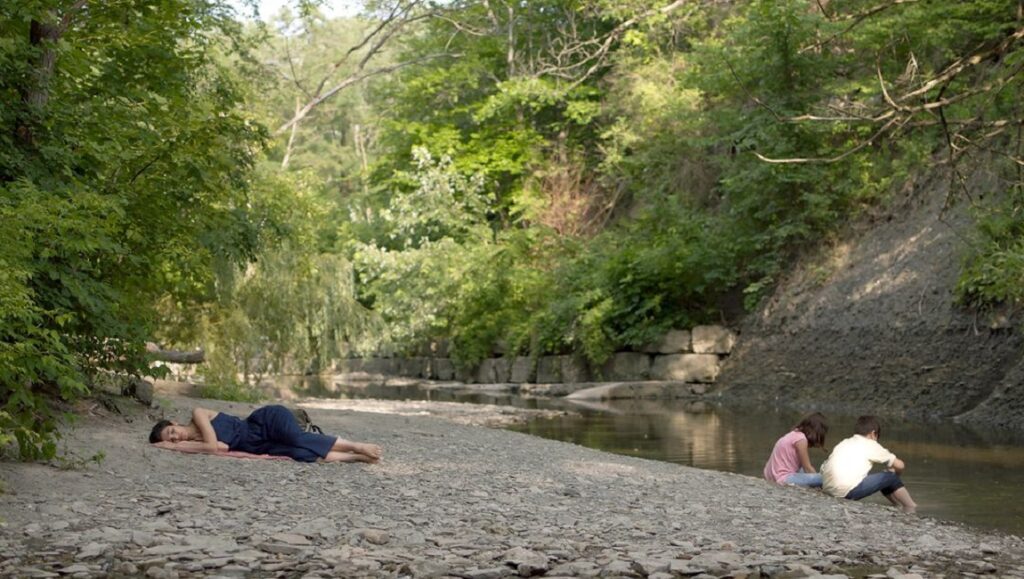The films of Antoine Bourges are measured by their restraint. Noted for their blurring of documentary and fiction, Bourges immerses himself in under-represented places at society’s periphery to create granular portraits of people, whose idiosyncrasies are more readily expressed by what they don’t say than what they explicitly communicate. Often marred by the constraints of language, he gives a voice to marginalized people whose experiences are often not afforded the patience, or empathy, to be properly understood. From the opiate-addicted denizens of Vancouver’s east side visiting the methadone clinic in East Hastings Pharmacy, to the mentally ill malefactors in Fail to Appear, to the immigrant families trying to find their footing in Toronto’s Thorncliffe Park in Concrete Valley, Borges’ naturalistic approach cultivates a sense of emotional intimacy with people of diverse backgrounds and challenges. His austere humanism strips them of the preconceptions and labels that we as viewers regularly defer to in the rush of life, labels that ultimately invalidate the full personhood of the other. With a keen, compassionate eye, and an unwavering commitment to specificity, Bourges’ approach conveys universalities of human experience in the granular distinctions of his subjects, by distilling them to their most vulnerable human forms, inconsistencies and all.
Beginning on February 23, his most recent feature film, Concrete Valley, and two mid-length features, Fail to Appear (2017) and East Hastings Pharmacy (2012), will screen for New York audiences at Manhattan’s Metrograph theatre, along with two of the director’s shorts. Ahead of this mid-career retrospective, I had the pleasure of sitting down with Antoine and speaking with him about his unique, boundary-defying work.
Conor Truax: Your films very naturalistically capture people and place; in East Hastings Pharmacy, for instance, where we became intimately familiar with a small methadone clinic in East Vancouver. Sometimes there are glimpses through the glass door that look under the street where the greater world hums along. But as a filmmaker, you’re really bridging those two worlds when people watch your films. A symptom of the bridge in that space is you and your camera. How do you go about researching the space before you begin shooting, and also how you go about dealing with your camera’s presence and making the non-actors you use feel comfortable and unbiased by the camera?
Antoine Bourges: I think the space is the starting point or has been the starting point for almost all my films, just to visit a place or stumble upon a place and becoming interested in what is going on or sensing a tension between what I can and can’t see. With the pharmacy, for instance, it was something that I would walk past often. There are a lot of them in the east end of Vancouver’s downtown, these very specific pharmacies that have this Plexiglas, which maybe now is not as odd, but at the time I found quite shocking and sort of disrespectful: to have this glass that separates the working people and the community. But then, seeing how people would go to these pharmacies and enjoy speaking with the pharmacist and enjoy being there and staying there as a social place, was revelatory.
My approach is about spending a lot of time there because all of my films begin with this feeling of curiosity, and I can’t really feel comfortable making them until I really feel like I understand and that I know people and that these people will collaborate with me to guide me through representing their space. I can’t really make these films the way that you would make a traditional film where you can just direct someone to do something. I really need the performers that know more about this world to help me as I shoot. I spend a lot of time just getting a sense of how it feels to be there, the feel of the place and the feel of the people in the place and how they are, how they speak, how they behave.
In terms of performances, I have always been fascinated by the way we are in everyday life — how we are all actors, even when we are just behaving normally; that performance or behavioral quality that we have in daily life. I want to preserve that because I feel that it’s interesting and exciting and mysterious, and that should be in films. I try to find a way, especially with non-actors, to put them in situations where they know they’re performing. Part of that is making them feel as relaxed as possible to allow them to reveal idiosyncrasies about themselves and the way they move, the way they talk, and slowly, it begins to appear in the films.
CT: I’ve been surprised that others haven’t invoked a comparison to Frederick Wiseman, because there’s such a strong sense of place, research, richness of context that you bring to your filmmaking. I read in an interview where you talked about creating filmmaking conditions that would allow for mistakes to happen all the time: I’m curious how you go about that, and if you could elaborate a bit more on your approach to creating those conditions?
AB: The first one is to work with non-actors that will allow mistakes to happen all the time. Then, it’s about allowing people — allowing shots — to run a little bit longer than traditional to allow for something to happen. When I say mistake, it could be the tiniest thing, something very small, but I think I find that when I allow shots to run a little bit longer, these things can sort of emerge a little bit. I don’t want to call them tricks because they’re part of what I find beautiful and exciting about movies, but that’s part of making a film: just choosing what things most excite you.
In terms of the Wiseman thing, I love his work, and I think about his work often. When I first watched his films, there was something being revealed to me. The beauty of his films is not a secret: you watch these people asking for things or trying to negotiate things, and you’re both watching because you want to know whether they’re going to get it and how they’re going to get it, but you’re also fascinated by their presence. And there’s a way to capture a presence in his films that is incredible. There’s almost a stasis sometimes where he finds a way to find situations where people end up quite physically not moving. And it’s just almost like Bresson, where people are stuck, just asking for things. He finds a way to bridge this documentary approach with a static stylization that doesn’t seem precious in any way. He was an early influence, as was the work of Lee Friedlander, when I started working on East Hastings Pharmacy. Lee was also interested in institutions at one point, and he took photographs of people working in offices and being very absorbed in their tasks, even though the photographs were being taken from very close to them. It was very moving to me to see people very invested and absorbed in something, even though there’s a camera right in front of them and you sense that there’s a complete awareness of being recorded, of performing. But at the same time, there’s an absorption, and for the viewer you have a privileged viewpoint that is also very self-effective because you are forced to think about performing socially and trying not to anyway.
CT: I have a question on that point of social performance a bit later on. But before then, I wanted to ask about the title of that interview I referenced, which was “Real People, Artificial Drama.” Your films draw a thin line between fact and fiction. Is that dichotomy fair? Is the drama in your films “artificial”?
AB: I guess it depends on your definition of drama. I think that what Teyama [Alkamli] and I wrote for the film is artificial.
What carries its own dramatic weight is the fact that people in the film are themselves refugees that agreed to work on the film because they believe in the project. Like a documentary subject — and I don’t know if it’s the right word — but they carry some of their story with them.
CT: To that point, your approach is deft at capturing the tensions and awkwardness between people in more fractious moments, especially people at the margins, as you said, and especially people who have difficulties communicating. But you’re also able to capture an incredible tenderness. Capturing awkwardness between non-actors seems intuitive, but how do you go about facilitating emotional intimacy between people who have less experience in front of the camera?
AB: When I’m on set and working, what translates on camera might not necessarily be the thing I’m seeing. Sometimes, I can feel it on set. I try to have people feel a warmth for one another, and they were chosen for that reason; they didn’t just happen to be that way. Again, with patience sometimes these warmer moments pop up, and I can’t really tell why or how they happen, but I’m there to capture them.
CT: Now going back to what we were speaking about in terms of social performance. What I love about your films is how they draw attention to what Erving Goffman called social dramaturgy, or the way in which we play different roles, with different scripts, depending on who we’re speaking to. For instance, in Concrete Valley, Farrah is auditioning different social roles for herself. She’s doing things she has never done before, and her husband is confused. We often think about performance as being artificial. How has your filmmaking process influenced your perception of performance, and how do you view your role as a director, dictating the representation of reality?
AB: Social performance is something that really interests me. The idea of authenticity and how we present ourselves, and how we connect to feeling authentic. In Concrete Valley, Rashid and Farah are going through a crisis that is deeply connected to this sense of authenticity. I find it such an interesting problem, because if there is a self-consciousness about being authentic, then we try to behave in a way that aligns with our authenticity. But then, by definition, if we’re making the choice, we’re incapable of a direct authenticity. Personally, I think that’s a beautiful thing. It’s nice that we’re not just one thing. It can be very terrifying, but at the same time, it introduces an element of choice — of non-determinism — that I find exciting. I think of that issue of authenticity as one of the key themes in the film, and also in the way I make films.
As a director, I often think about my role, especially in choosing to work with non-actors and asking them to perform roles that are close to who they are, while also giving them the freedom to choose a character name or inhabiting characteristics of a friend or someone else in their life. Allowing for this elasticity and seeing what happens is often optimistic. Even if it’s a person is struggling and going to a methadone pharmacy [East Hastings Pharmacy], and even if the subject is bleak, there’s an optimism when you see someone perform a version of themselves.
CT: I also think that the emphasis on social performance in your films brings the attention of viewers to the fact that everyone performs, and in turn, everyone has a creative capacity, even if it gets lost in the rush of day-to-day life.
AB: Yes, we all want to create stable images of ourselves, or images that are kind of stable. We don’t want things to shift too much because there is comfort in consistency. But I don’t think that’s the case for anyone. I’m interested in trying to reveal that. Even when we scripted Concrete Valley, we were hoping that the performers would show different sides of themselves. In my films, it’s not so much that there’s a drastic character arc. Instead, the characters are staying more or less the same, but we see different parts of them depending on who they speak to. Someone could be optimistic with one person while speaking more fluently in one language, and then seem more down when speaking less fluently. I’m the person I am with you, and then totally different with say, my friend. We can understand that intuitively in our real life, so I feel like it’s special when movies can inject that, too.
CT: In Fail to Appear, Isolde is a trainee social worker with a literature degree hoping to apply her sense for story and character to a practical environment, very much in the same way you do as a director. I read that you don’t write the endings of your films. Are you constantly writing throughout the filming process, or making decisions about finality in editing?
AB: I script everything, so the trajectory is clear, but I always struggle with coming up with an ending. I’ll either have none or I’ll have two or three that I shoot, and I’ll shoot them all in twenty different ways. I’m not trying to fish blindly for a conclusion. For me, it’s a discovery process to see how a character evolves alongside the film. I ask, where will this take them? There’s a looseness, although not as extreme as [something like] Tarkovsky’s Mirror.
With any fictional film, you create a grammar, and the audience adjusts to that grammar, which will dictate what you can do believably in terms of narrative shifts or drastic decisions. And if you don’t do that, if you do things in a smaller tone or register as I do, then the liberty you have to make these shifts is reduced.
You can write something but quickly you realize that it doesn’t work, because of how real the film feels, and because reality very rarely provides a neat ending with a drastic change. That’s why it’s tricky to have an ending on paper. I need to shoot it; to see it to believe it. And sometimes I don’t, so we need to create new endings.
CT: Your films are very literary in some ways. The interiority of characters is totally denied to us, and there’s never any score to help allude to how they might feel. How are you able to toe this line between the emotional intimacy that you develop and the emotional insulation that you risk in your approach?
AB: To the point around music, that was a dogma for me at first, because the films that I loved were ones that didn’t have music. Now, I would try music in my films, and I would have even done so in Concrete Valley, but there’s an art to making a film that can take music, and I’ve never done it, and I don’t know how, because I haven’t tried.
In terms of intimacy, I’m interested in depicting the way things reveal themselves in real life, and so I’ll take things I observe in real life and bring them into the film. I try to maintain that in the writing, and when the actors try to ad lib, I make sure they aren’t revealing things in a way that isn’t natural, and not just a direct projection of how someone feels. It’s the work of the director to pay attention to these small tonal considerations. If someone is lying, they shouldn’t be acting like they’re lying. In real life, when people lie you don’t notice it. They don’t act like they’re lying. When you become hyper-aware of those smaller things, you become allergic to things that say anything more than what needs to be said.
CT: We spoke about it earlier, but in all your films, especially Concrete Valley, there’s this motif around language. You really outline the constraints of language in a way that we might take for granted day to day. A lot of the characters express discontent about not being able to express themselves properly because in turn they don’t feel like they’re being, they’re able to be, understood. In Concrete Valley, the family has immigrated from Syria and is experiencing this bilingual doubling of their lives. In that one striking scene, Rashid sees his wife, Farah, speaking English and sees her as a different person — a stranger. Your first language is French. I’m curious how you think operating in different languages might influence the way we think?
AB: I think especially if you don’t speak the language very well, then it really affects how you see yourself when you’re in the world. You can’t make jokes. You can’t imitate people. You can’t even count really. I still count in French in my head. I can’t count. I mean, I can count in English, but if I have to do a real count, it’ll be in French. There’s always a sense that you go back to a base. And it’s nice to have it, but that also makes you always aware that you have to rely on this other thing that’s the base and that what you’re trading with day-to-day is this other thing that’s not your base. It makes you feel jealous of people who have a complete, direct, fluent connection between them.
It’s something you always think about when you’re somewhere where your mother tongue is not the language of the place you inhabit. In North America, we take it for granted. People don’t bat an eye at an accent, but I do think it still affects how you get things done, how you’re respected, or, more importantly, how you perceive whether or not you’re respected and your general level of comfort. It affects the way you sit and move and your gestures, and seeing the difference between how the characters in Concrete Valley behave differently at home versus in the world is interesting. Even when they can speak fluently to one another, there’s a communication barrier of a different kind. I always think about this when I see it in real life, so I wanted that to be a big part of the film. And it’s a huge part of the neighborhood because the place where they learn English is at the center of a circle made of high-rise buildings that create a courtyard. Very literally, I knew this had to be at the center of the film.
CT: By investigating social performance, your films end up highlighting the performance of gender roles, and their frictions. In Concrete Valley, Rashid is a repressed male figure. Even in the first scene, as Farah cares for their son, you’re unaware that he’s present until he’s directly referred to. Because he was a doctor in Syria, he refuses work that he views as below him, but in turn, he relies on his wife to provide for the family. Do these tensions arise organically, or are they concerted points of investigation in your work?
AB: I don’t think about grander themes, like gender, immediately. I always think very specifically in terms of the characters. I want to make it as specific and idiosyncratic as possible to feel like these characters are real, distinct people. In time, these roles, and inequality in general, become very evident. There’s a clear inequality in Rashid and Farah’s relationship in Concrete valley, but it’s not a theme we started with. I observed it when I was on sight in Thorncliffe Park, where the film takes place, but I didn’t put a name to it. It just came out in the film.
CT: To me, the specificity of the characters in your films is what allows for the atomic to become universal, and where their brilliance lies.
AB: Thank you. I feel fortunate to have the opportunity to show my films to audiences in New York at Metrograph, and hope that people find them unique and interesting. Not just about life in Canada, but about how we all live.










